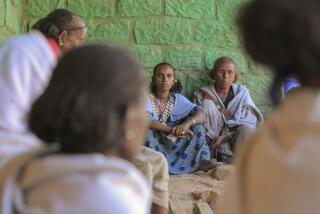Ethiopians’ Arrival Stirs Israeli Job Fears
- Share via
JERUSALEM — Several Israeli mayors, fearing the loss of jobs to immigrants, Friday denounced the mass airlift of Jews from famine-stricken Ethiopia, with one charging that the refugees were brought into his town “like thieves in the night.”
“We don’t have enough jobs to go around and they would end up with all the dirty work,” said Rafael Hochman, mayor of the southern Israeli resort town of Eilat, in an interview with the magazine Coteret Rashit (Banner Headline).
Mayor Chaim lvav of Nahariya charged that placing 300 of the Ethiopians, or Falashas, in his German Jewish-founded town would hurt tourism. He also said he had not been informed of the decision to send them to Nahariya.
“We welcome the newcomers but we are against the way it was done,” lvav said.
Menachem Ariav, chairman of settlement councils in the Upper Galilee and mayor of the town of Upper Nazareth, was more indignant. “In some cases we woke up in the morning to see them in vacant flats in our settlements,” he said. “The newcomers were brought into new apartments like thieves in the night.”
The mayor of the depressed Negev town of Yerucham said, “God willing, we won’t have to take them.”
A seemingly embarrassed Ethiopia was not happy about the revelation of the airlift, either. It charged “illegal trafficking” in Ethiopian citizens and also claimed that the refugees were transported against their will.
“The Ethiopian government reiterates that it is in no way involved in this sinister operation and strongly objects to this gross interference in its internal affairs,” a Foreign Ministry statement issued in Addis Ababa said.
The statement said Sudan and other unidentified countries were cooperating in the “illegal and clandestine operations” and called for a halt.
It rejected charges that the Ethiopian Jews have been denied religious freedom. The Falashas, it said, share a language, tradition and cultural life indistinguishable from others in their native northern province of Gondar, which borders Sudan.
Some Ethiopians entered Sudan because of the “catastrophic drought” while others have been “forced and enticed” across the border by counterrevolutionary groups, the statement asserted, apparently referring to secessionists helped by the pro-Western Sudanese authorities. Sudan’s relations with Marxist Ethiopia have been largely hostile.
According to reports carried by Israel radio and the newspaper Hadashot, the United States contributed $5 million to the airlift, which began six weeks ago amid a drought-based Ethiopian famine that is threatening millions with starvation. The famine, the worst in recent African history, is afflicting 27 countries in all parts of the continent. Ethiopia, with some of the most desperate conditions, has gotten the lion’s share of international attention.
The newspaper said that Israeli Prime Minister Shimon Peres raised the question of the Falashas during a visit to Washington in October and that “Secretary of State George Shultz stepped forward to act and immediately let Israel have $5 million for the operation.”
In Washington on Friday, State Department spokesman Alan Romberg declined comment on the $5-million aid report but did not deny that there had been American involvement.
“The United States has been working quietly and closely with a number of organizations and governments to save the lives of the African refugees, including African Jewish refugees,” he said.
The Israeli airlift was code-named “Operation Moses,” a reference to the exodus of the Jews from Egypt in biblical times. It has brought in thousands of the Falashas, an often-primitive and isolated people who trace their ancestry to the days of Solomon and Sheba.
Evidence of how great a change the Ethiopians are experiencing was visible in the seaside city of Ashkelon. There, at the headquarters of the rescue mission, about 100 of the immigrants sat on the lobby floor of the three-star hotel that is their first stopping point on the way to resettlement.
Wide-eyed children clung to their mothers’ legs, clearly wary of their new surroundings, as the new Israelis received identity papers, warm jackets and tennis shoes.
As Jews, the Ethiopian refugees are covered by the “right of return,” which entitles them--or any Jew--to immediate Israeli citizenship and the right to residence in Israel. Still, the impact of their immigration provoked some soul-searching in Israeli news media.
Uzi Bar-Am, head of Parliament’s immigration committee, said on Israel radio, “The Jews of Ethiopia have a mark of recognition (color) that no other Jews have, and that could lead to reservations on the part of some Israelis unless there is a wide-ranging information campaign.”
Education Minister Yitzhak Navon, a former Israeli president, agreed. “We are witnessing one of the greatest miracles,” he told the Armed Forces radio. “A severe problem we’re facing is that of color. We’re facing a true test of the society in Israel.”
The nation’s hospitals, hotels and army centers mobilized Friday to begin the long absorption process, vowing not to repeat mistakes of 35 years ago that embittered Sephardic Jews on their arrival. The Sephardim, who these days form a majority of Israeli Jews, recall being sprayed with pesticide after landing as immigrants in 1948, 1949 and 1950. A total of 50,000 Yemeni Jews and 120,000 Iraqi Jews arrived on those flights.
Many are bitter to this day toward the Ashkenazic, or European Jews, who dominated the new state, ran its fledgling bureaucracy and channeled them to their spare new lives.
More to Read
Sign up for Essential California
The most important California stories and recommendations in your inbox every morning.
You may occasionally receive promotional content from the Los Angeles Times.












